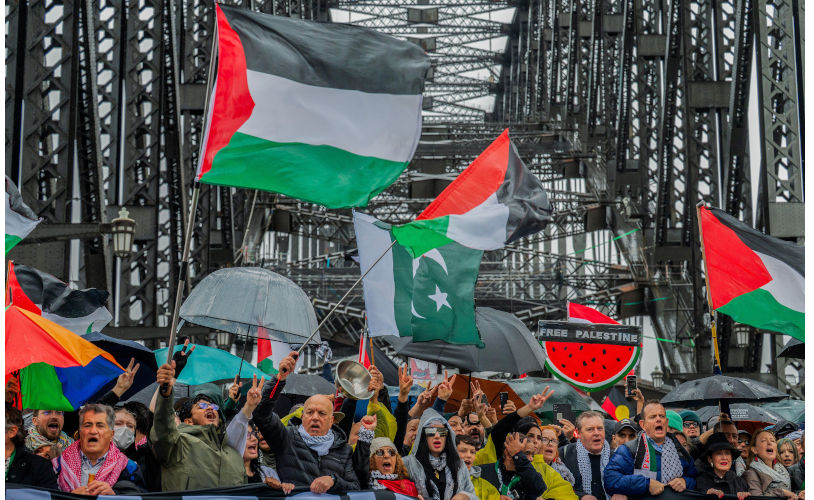Watermelons in the rain
August 7, 2025
We knew a thousand police couldn’t arrest 90,000 of us, so the march for Palestine was always going to happen. An 11th-hour decision by Justice Belinda Rigg just made it legal.
Every Sunday since October 2023, pro-Palestine rallies, loudish but always peaceful, with relaxed police making no arrests, have been part of the Sydney scene. For the huge event we’ve just had, they were the warm-up. And just as well, because Sunday 3 August was so cold and wet.
Those who thought the weather would deter the marchers were disappointed. That would have included the Premier Chris Minns and the NSW police commissioner. So they resorted to other tactics and got their way in the end.
But before they did, there was sound, colour and movement all the way from Wynyard, up York street, and onto the bridge. While the sun was out, everything sparkled, and flags in watermelon colours waved. When it rained, on with keffiyehs and up with watermelon-patterned umbrellas. Watermelon-dangle earrings are the current political fashion statement.
Anyone who thought multiculturalism was killed off by John Howard was disappointed too. A wider, more spontaneous representation of Australian society couldn’t have been contrived. The marchers included thousands of old and young, whole families, babies, and people of many origins.
From the middle of the crowd, we couldn’t tell how far we were from the back of the pack — like in City to the Surf — or see how far ahead the leaders were. But it wasn’t a race to the finish, and not even a march, as much as a slow shuffle taking up the whole width and length of the bridge.
We couldn’t see Julian Assange with Bob Carr. Nor Clover Moore in her wet black hat, nor persecuted re-tweeters Mary Kostakidis and Antoinette Lattouf, nor the ALP, Green and Independent politicians who were at the front. Coalition members were even less visible.
So were the police horses, but they left evidence of their presence, which we had to avoid stepping on. A sea-plane from Rose Bay flew over for a look, as did a couple of news helicopters. Trains passed and passengers waved. But the best view was had by bridge climbers, who on a grey misty day could instead watch the whole march from above.
Then we realised the latest helicopters were police, and they were flying low, addressing us. The march kept stopping. Everyone got messages on their phones (how did they have all our numbers? no-one we knew had registered to march). Because of the danger of a crowd crush at the northern exit from the bridge, we read that we all had to stop and go back. Some people were already returning south on the side walkway, like New Yorkers escaping from the World Trade Centre.
We had been walking for two hours and had only just passed the halfway point on the bridge, under the Aboriginal flag. One man who remembered the Vietnam protests, and the Iraq demonstration, said we should all just sit down. My Chinese Australian friend went and demanded an explanation, and police told her it was for our safety.
They made us all turn round, and we did. So the crowd went back, still banging saucepans, still cheerful, still chanting “from the river to the sea” and “we don’t want your bloody war”, etc. But it made me feel a little of what the Palestinians have put up with for decades, being pushed here and there, told to go north, go south, go to a concentration camp.
We were many more than 90,000, according to my statistically-inclined friend Bevan Ramsden, who compares our event with an anti-Vietnam war march on Bourke street in Melbourne on 8 May 1970. Police said there were 70,000 packed marchers, and the organisers claimed 100,000. The length of the march, 500 metres, was the same as the span of the Sydney Harbour Bridge. The bridge (eight lanes) is twice as wide as Bourke Street (four lanes), and the official length of the bridge is 1.15km, more than double its span. The length of the Sydney march was even more than that, going back past Lang Park. So Bevan calculates that there were between 280,000 and 400,000 Marchers for Humanity on Sunday.
The march never reached its destination, the US Consulate-General in North Sydney. Public transport was closed all over the CBD, so people walked to wherever they could find a way back to their cars and their dry, warm homes. We all felt we had done something memorable. It was the opposition from government and police to the march that brought hundreds of thousands of us out in the rain. The point we made has clearly registered.
The views expressed in this article may or may not reflect those of Pearls and Irritations.

